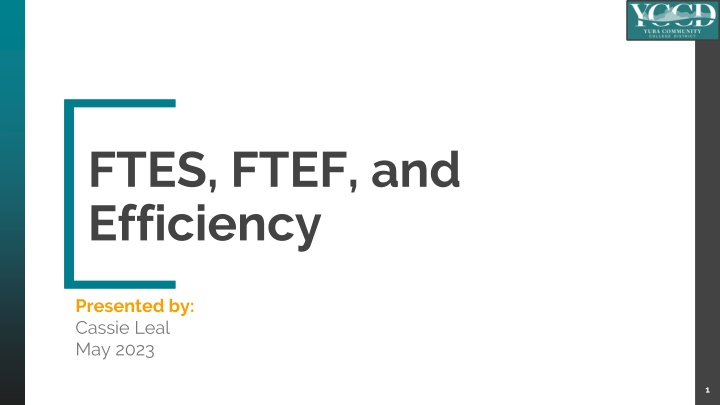
FTES, FTEF, and Efficiency in Enrollment Management
Explore the concept of Full-time Equivalent Student (FTES) and its significance in strategic enrollment management (SEM). Learn about the purpose of SEM, trends in FTES, and strategies to promote student success and fiscal stability. Discover the formula to calculate FTES and its role in funding education institutions effectively.
Download Presentation

Please find below an Image/Link to download the presentation.
The content on the website is provided AS IS for your information and personal use only. It may not be sold, licensed, or shared on other websites without obtaining consent from the author. If you encounter any issues during the download, it is possible that the publisher has removed the file from their server.
You are allowed to download the files provided on this website for personal or commercial use, subject to the condition that they are used lawfully. All files are the property of their respective owners.
The content on the website is provided AS IS for your information and personal use only. It may not be sold, licensed, or shared on other websites without obtaining consent from the author.
E N D
Presentation Transcript
FTES, FTEF, and Efficiency Presented by: Cassie Leal May 2023 1 1
Overview YCCD SEM Purpose Statement FTES and Trends FTEF and Efficiency Questions 2 2
YCCD SEM Purpose Statement Draft The purpose of the Yuba Community College District (YCCD) Strategic Enrollment Management (SEM) is to develop a holistic, comprehensive, and integrated approach to enrollment management while focusing on scheduling, professional development, instructional, and student support strategies to enhance access, success, persistence, and goal attainment. At YCCD, all constituents play a role in Strategic Enrollment Management. Student success is central to all related planning, practices, and processes. 3 3
YCCD SEM Purpose Statement Draft The purpose of SEM is to: Promote student success by improving access, engagement, persistence, and completion. Offer quality and relevant programs with clear educational pathways, course offerings, and appropriate student support. Implement strategies that lead to equitable access and outcomes. Establish comprehensive productivity, efficiency, and enrollment goals that are aligned with the college and district mission statements, priorities, and integrated plans. Ensure fiscal stability and viability by optimizing enrollments and integrating SEM into the college financial planning, budgeting, and resource allocation processes. Design and implement communications and marketing strategies with internal and external stakeholders. Increase collaboration among departments across the campus to support the goals of the institution. Cultivate a data-informed culture that can effectively utilize data to inform decisions and evaluate activities, programs, and services. 4 4
FTES and Trend 5 5
Why? Proportions of SCFF Elements Why should we care about FTES? Success 20% Fulltime Equivalent Student (FTES) represents the largest portion of the Student Centered Funding Formula (SCFF) FTES 60% Supplemental 20% Source: CCCCO Student Centered Funding Formula 6 6
What is an FTES Fulltime Equivalent Student (FTES) was established in 1988 to provide a standardized workload measure for college funding. The basic formula to calculate FTES: FTES = Total Student Contact Hours (TSCH) / 525 2020-21 value of 1 FTES = $4,285* Source: 2019 IEPI SEM Resource Guide: Understanding and Calculating FTES and Efficiency *Represents an estimate-Source: CCC 2021-22 First Principle Statewide Totals Exhibit C 7 7
What is an FTES Three Types of FTES Resident FTES CCCCO uses this FTES to determine funding allocations to the colleges within the state Non-Resident FTES Are FTES generated by out-of-state or out-of-country students Total FTES The sum of all FTES (resident and non-resident). The value YCCD uses to determine the targets for colleges 8 8
A Single FTES Represents A student or group of students Attending 15 hours per week For two semesters of 17.5 weeks For a total of 525 Contact Hours What is an FTES? To Summarize: 9 9
YCCD offered a section of XYZ-1A with 30 students enrolled at census. What is an FTES? 54 lecture hours 30 students 54 x 30 = 1,620 total student contact hours Example 1: 1,620 / 525 = 3.09 FTES 10 10
YCCD offered a section of XYZ-1A with 19 students enrolled at census. What is an FTES? 54 lecture hours 19 students 54 x 19 = 1,026 total student contact hours Example 2: 1,620 / 525 = 1.95 FTES 11 11
YCCD Total FTES History 9,000 8,000 5 YR Ave: 6,746.26 7,000 YCCD was experiencing FTES declines even prior to the pandemic 6,000 5,000 4,000 7,798.84 7,658.47 7,619.15 7,552.46 7,542.73 7,444.40 7,291.55 7,130.65 7,061.41 7,106.06 6,153.96 3,000 5,735.35 2,000 1,000 0 2010-11 2011-12 2012-13 2013-14 2014-15 2015-16 2016-17 2017-18 2018-19 2019-20 2020-21 2021-22 Total FTES Source: Enrollment Snapshot Report 12 12
FTEF and Efficiency 13 13
What is an FTEF Fulltime Equivalent Faculty (FTEF) is a measure used by the State to calculate the total sum of faculty resources, part-time and fulltime combined, in units of 151 hours per week of teaching time . The basic formula to calculate FTEF for lecture: FTEF = Total Load / 15* Remember: Labs are calculated at 85% of this formula *15 is used for terms 30 for AY 14 14
At YCCD a 3 unit XYZ-1A class has 54 lecture hours. Step 1: Solve for Load What is an FTEF? Load = Lecture Hours / 18 54 / 18 = 3 Load Step 2: Solve for FTEF Example: FTEF = Total Load / 15 3 / 15 = 0.2 FTEF 15 15
Why? Why should we care about efficiency? Districts and colleges must develop and maintain fiscally viable schedules to offset the cost of offering classes and, hopefully, generating revenue that allows us to continue to offer and expand programs and services for students. Tracking efficiency and setting targets allow us to do this. 16 16
Calculating Efficiency YCCD has transitioned to using FTES/FTEF as the preferred measure of efficiency because it is a straightforward calculation. Generally accepted efficiency target for California Community Colleges: 17.5 for terms 35 for academic years Source: 2019 IEPI SEM Resource Guide: Understanding and Calculating FTES and Efficiency 17 17
FTES/FTEF To Average Class Size Term FTES/FTEF 17.5 17 16.5 16 15.5 15 14.5 14 13.5 13 12.5 12 Annual FTES/FTEF 35 34 33 32 31 30 29 28 27 26 25 24 Average Class Size 35 34 33 32 31 30 29 28 27 26 25 24 Calculating Efficiency What does it mean? 18 18
Example 1: XYZ-1A with 30 students enrolled at census. 3.09 / 0.2 = 15.45 efficiency Calculating Efficiency? Example 2: XYZ-1A with 19 students enrolled at census. FTES / FTEF = Efficiency Efficiency Target: 14.0 1.95 / 0.2 = 9.75 efficiency 19 19
YCCD Total FTES and Efficiency History 9,000 18.0 16.8 16.6 8,000 16.0 15.1 14.0 13.9 Prior to our SEM Academy participation, Efficiency was not a major priority for our district 13.6 13.5 13.3 7,000 14.0 13.0 13.0 12.9 12.5 6,000 12.0 5,000 10.0 4,000 8.0 7,798.847,658.47 7,619.15 7,552.46 7,542.73 7,444.407,291.557,106.06 7,130.65 7,061.41 6,153.96 3,000 6.0 5,735.35 2,000 4.0 1,000 2.0 0 0.0 2010-11 2011-12 2012-13 2013-14 2014-15 2015-16 2016-17 2017-18 2018-19 2019-20 2020-21 2021-22 Total FTES FTTES/FTEF Source: Enrollment Snapshot Report 20 20
Questions 21 21






















